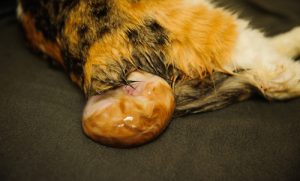Cats give birth at around 8-9 weeks of pregnancy. This article provides a guide on what to expect in a cat giving birth, so you can easily recognise what is normal to reduce any anxiety that this moment may bring. As well as what is not normal so you can call for help without delay.
Birth in cats is also known as labour, kittening and queening. One of the signs that you should seek emergency vet care is if your cat is having strong, continuous contractions that have continued for more than 20 minutes without a kitten being born.

Why
Preparing for your cat’s labour
Cat pregnancies last around 65 days (9 weeks). Two weeks before birth (from week 7 of pregnancy) you should:
- Take her for a vet check to help rule out any problems. Your vet may give you a rough estimate of how many kittens to expect.
- Prepare the nesting area.
- Familiarise yourself with the emergency signs of labour so you know when to call for help.
- Get the emergency vet number and location in case of need.
Visit our other articles for information about cat pregnancy and c-sections.
Building a nest for your cat
Things to take into consideration:
- Private place (to minimise disruptions, loud noises, people passing by, and other pets)
- Warm and comfortable
- Nest box
- cardboard box lined with absorbable pads
- filled with clean blankets, sheets or towels
Things to lookout for
Signs your cat is in labour and the stages that follow
Be prepared for the process to last around 24 hours. Nobody’s going to get much sleep!
Understanding the 3 stages of labour in cats:
Stage 1
- Restlessness, pacing, hiding, nesting behaviour
- Mum’s rectal temperature drops to around 37 degrees Celsius
- Lasts an average of 6-12 hours
Stage 2
- Stronger contractions lead to the first kitten delivery
- First kitten is usually delivered within an hour of the contractions starting
- Mum licks the kitten intensively, breaking the membrane covering them and biting through the umbilical cord
- Birth of the first kitten usually takes the longest
- The interval between kittens can be between 5 minutes and 2 hours, depending on the size of the litter
- Mum may rest for 2-4 hours during labour
- The total duration of this stage is usually between 3-12h
Stage 3
- Placenta may be delivered at the end or between kitten deliveries
When to worry
When to call the vet during your cat’s labour
Take your cat to the nearest vet practice if:
- Labour hasn’t started within 24 hours of the drop in rectal temperature (below 37 degrees Celsius).
- Stage 2 of contractions started more than 4 hours ago, and the first kitten is yet to be delivered.
- Strong, continuous contractions persist for more than 20 minutes without kitten delivery.
- You notice a green or black discharge from your cat’s vagina.
- Your cat has heavy bleeding, pain, weakness, or other signs of distress.
- Pregnancy lasts more than 71 days.
What to do
What you can do to help your cat during labour
When your cat first goes into labour, the best thing to do is keep your distance while quietly observing her.
You might be surprised to learn that cats don’t typically need much help giving birth, and it may even disturb them.
Nevertheless, get some items in case of need:
- Clean towels
- Sterilised scissors (boiled for 5 minutes)
- String or floss
If the mother does not remove the membrane covering the kitten within roughly 2 minutes, you will need to assist.
- Carefully break and remove the membrane using your fingers.
- Tilt the kitten’s head down and rub them with a towel to remove all the debris from their nose and mouth and to help them start breathing.
- Tie the umbilical cord with string or floss (unflavoured and unwaxed ideally) about a half inch from the kitten’s belly.
- Cut the cord with sterilised surgical scissors about half an inch away from your knot.

What not to do
What not to do with your cat in labour
As the owner, you know your pet best, but keep your distance at first, most cats prefer not to be disturbed.
Wait for labour to be completed and all appear settled to start cleaning the mom and birth box.
- Do not upset or move the mother or the kittens too much
- Use warm water and a clean cloth
- Do not use any soaps or disinfectants
- Remove any dirty absorbable pads or bedding from her whelping box only after labour has been completed
- Avoid disturbing them during and after birth
When is it normal
How many kittens does a cat give birth to?
In cats, litter size may vary between 1 and 9 kittens. Usually, the average is 4 kittens.
For first-time mums, the litter size is usually smaller: an average of 2 to 3 kittens.
It is very important to have vet checks during pregnancy in cats. Not just to confirm the number of kittens expected at birth but also to prevent any complications during labour.
What to expect after your cat gives birth
After a cat gives birth, it’s essential to monitor them closely for any unusual symptoms.
Here’s what you can generally expect:
- Discharge from vagina:
- Small amounts of reddish-brown discharge are normal for a few weeks after giving birth.
- Energy levels:
- Initial fatigue. Mum may spend a lot of time resting with her kittens.
- Energy levels should gradually improve over the following days and weeks.
- Appetite:
- Appetite may increase, especially as the demands of nursing kittens require additional calories.
- Vomiting and diarrhoea:
- Cats may experience vomiting or soft stools after eating the placenta. If she experiences more than one episode, consult a vet immediately.
The first few days with newborn kittens
- Allow mum to bond with her kittens and provide a quiet, warm, and safe environment.
- Monitor the kitten’s weight gain weekly, ensuring they are nursing well.
- Keep the whelping area clean and comfortable, and avoid unnecessary disturbances.
- Schedule a postnatal vet check-up for both the mum and kittens on day 3 or 4.








